Atlanta peronii
Roger R. SeapyIntroduction
Atlanta peronii is the type species in the genus Atlanta. It attains the largest size of all atlantids (to 10 mm shell diameter). The walls of the shell are unusually thick and strong. The keel is moderately tall and rounded in side profile, with a slightly truncated leading edge. The keel base is clear in young animals, but changes with age to a light brown and then a dark yellowish-brown. The keel inserts between the fourth and fifth whorls in shells larger than about 3 mm. The spire consists of 3-1/2 to 3-3/4 whorls. The whorl surfaces are smooth. The sutures between the first and second whorls are shallow, while those between subsequent whorls are incised. Full grown shells can consist of up to 6 whorls. Shell transparent, but can become faintly yellow in large individuals. Eyes type b. Operculum type b. Radula type II, large with sexually-dimorphic marginal teeth. The species is cosmopolitan in tropical to subtropical waters. In Hawaiian waters, A. peronii is a strong nocturnal vertical migrator, ranging downward to a daytime maximum of 300 m and migrated into the upper 150 m at night.Diagnosis
- Maximal shell diameter = 10 mm
- Shell with thick, strong walls, consisting of up to 6 whorls
- Shell transparent, but becomes a faint yellow in older animals
- Keel moderately tall and rounded, inserting between fourth and fifth whorls in shells larger than about 3 mm
- Keel base clear in young individuals, becoming brown to yellow-brown with age
- Spire consists of 3-1/2 to 3-3/4 whorls
- Sutures between the first and second whorls shallow; subsequent sutures incised
- Spire whorls smooth
- Eyes type b
- Operculum type b
- Radula type II; large, with sexually-dimorphic marinal teeth
Characteristics
- Shell
- Shell diameter to 10 mm
- Shell with thick, strong walls; wall thickness = 22-25 µm (Richter, 1993)
- Spire consists of 3-1/2 to 3-3/4 whorls; shell of full-grown individuals with up to 6 whorls
- Surface of spire whorls smooth
- Sutures between the first and second whorls are shallow; sutures between subsequent whorls are deeply incised (see fourth SEM image below)
 Click on an image to view larger version & data in a new window
Click on an image to view larger version & data in a new window
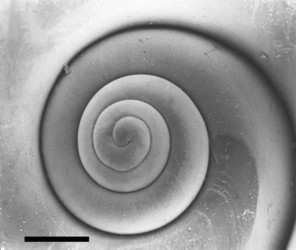
Figure. Scanning electron micrographs of a 3.8 mm Atlanta peronii shell viewed from the right side. Shell at low magnification (left) and spire at high magnification (right). Scale bars = 0.5 mm (left) and 0.1 mm (right). © Roger R. Seapy
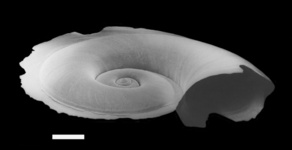

Figure. Scanning electron micrographs of a 3.8 mm Atlanta peronii shell viewed from the right side tilted. Shell at low magnification (left) and spire at high magnification (right). Scale bars = 0.5 mm (left) and 0.1 mm (right)©
- Keel rounded in side view, with a slightly truncated leading edge (see title illustration and first SEM image above)
- Keel inserts between shell whorls beginning at about whorl 4-1/4; at a shell diameter of about 3 mm (see first SEM image above)
- Keel base clear in young individuals (see photograph below), but changes with age from a light brown to a dark yellowish-brown (see title illustration) with age
- Shell transparent in small to moderate sized individuals (see photograph below), becoming faintly yellow in large specimens (Richter, 1993)
- Eyes type b; with a transverse slit in the distal pigmented tissue (see photograph below)
- Operculum type b (micro-oligogyre)
- Radula type II
- Radula large, with the number of tooth rows limited to about 60 (Richter, 1993)
- Lateral teeth tall
- Marginal teeth sexually dimorphic (Richter, 1993). In adult radulae marginal teeth of males shaped as sharply-bent hooks, with the result that they are much shorter than the respective lateral teeth. In females the marginal teeth are longer and less sharply curved (see photographs below)
Comments
An Atlanta peronii species group was recognized by van der Spoel (1976) that included three species; A. peronii, A. gaudichaudi and A. pacifica. Subsequently, A. pacifica was synonymized with A. peronii and A. gaudichaudi placed in its own species group that contained three species, A. gaudichaudi, A. plana and A. echinogyra (discussed in Richter and Seapy, 1999). The A. peronii species group now includes four species, A. peronii, A. rosea, A. fragilis, and A. frontieri. Richter (1993) resurrected as a valid species A. rosea, which had been described by Souleyet in 1852 but subsequently treated as a junior synonym of A. peroni by Tesch (1908, 1949), and the latter two species were described as new species. The current pair of species groups are distinguished by markedly different radulae (discussed by Richter and Seapy, 1999; see the genus Atlanta page).
Diel vertical distribution patterns of A. peronii off the leeward coast of Oahu, Hawaii was studied by Seapy (1990b, 2008). In the former study, the species ranged downward to a daytime depth of 200-300 m (the maximal depth interval sampled), and migrated into the upper 150 m of the water column at night. In the latter study, vertical distribution patterns were studied at three stations located at 1, 5 and 15 nmi offshore. The species was recorded to a daytime depth of 160-200 m at the 5 and 15 nmi stations, while at night a slight upward migration was suggested since the deepest depth interval containing specimens was 120-160 m at both stations. Also, the abundance of A. peronii decreased shoreward by 50% from the 15 nmi to the 1 nmi station (comparison based on the mean nighttime densities at each station).
References
Richter, G. 1961. Die Radula der Atlantiden (Heteropoda, Prosobranchia) und ihre Bedeutung f?r die Systematik und Evolution der Famiie. Zeitschrift f?r Morphologie und ?kologie das Tiere 50: 163-238.
Richter, G. 1993. Zur Kenntnis der Gattung Atlanta (V). Die Atlanta peroni-Gruppe und Atlanta gaudichaudi (Prosobranchia: Heteropoda). Archiv fur Molluskenkunde 122: 189-205.
Richter, G. and R. R. Seapy. 1999. Heteropoda, pp. 621-647. In: D. Boltovskoy (ed.), South Atlantic Zooplankton. Leiden: Backhuys Publ.
Seapy, R. R. 1990a. The pelagic family Atlantidae (Gastropoda: Heteropoda) from Hawaiian waters: a taxonomic survey. Malacologia 32: 107-130.
Seapy, R. R. 1990b. Patterns of vertical distribution in epipelagic heteropod molluscs off Hawaii. Marine Ecology Progress Series 60: 235-246.
Seapy, R. R. 2008. Offshore-inshore and vertical distributional patterns of heteropod mollusks off leeward Oahu, Hawaii. Marine Biology 154: 985-995.
Souleyet, [L. F. A.]. 1852. In: Eydoux, [F.] and Souleyet [L. F. A.], Voyage autour du monde execute pendant les annees 1836 et 1837 sur la corvette 'La Bonite'... Zoologie, col. 2. 664 pp. A. Bertrand, Paris.
Spoel, S. van der. 1976. Pseudothecosomata, Gymnosomata and Heteropoda (Gastropoda). Bohn, Scheltema & Holkema, Utrecht. 484 pp.
Tesch, J. J. 1908. Systematic monograph of the Atlantidae (Heteropoda) with enumeration of the species in the Leyden Museum. Notes from the Leyden Museum 30: 1-30, 5 plates.
Tesch, J. J. 1949. Heteropoda. Dana Report 34: 1-54.
Title Illustrations

| Scientific Name | Atlanta peronii |
|---|---|
| Location | Hawaiian waters |
| Specimen Condition | Live Specimen |
| Sex | Female |
| Life Cycle Stage | adult |
| View | right side |
| Image Use |
 This media file is licensed under the Creative Commons Attribution-NonCommercial License - Version 3.0. This media file is licensed under the Creative Commons Attribution-NonCommercial License - Version 3.0.
|
| Copyright |
©

|
About This Page

California State University, Fullerton, California, USA
Correspondence regarding this page should be directed to Roger R. Seapy at
Page copyright © 2010
 Page: Tree of Life
Atlanta peronii .
Authored by
Roger R. Seapy.
The TEXT of this page is licensed under the
Creative Commons Attribution License - Version 3.0. Note that images and other media
featured on this page are each governed by their own license, and they may or may not be available
for reuse. Click on an image or a media link to access the media data window, which provides the
relevant licensing information. For the general terms and conditions of ToL material reuse and
redistribution, please see the Tree of Life Copyright
Policies.
Page: Tree of Life
Atlanta peronii .
Authored by
Roger R. Seapy.
The TEXT of this page is licensed under the
Creative Commons Attribution License - Version 3.0. Note that images and other media
featured on this page are each governed by their own license, and they may or may not be available
for reuse. Click on an image or a media link to access the media data window, which provides the
relevant licensing information. For the general terms and conditions of ToL material reuse and
redistribution, please see the Tree of Life Copyright
Policies.
- First online 12 January 2010
- Content changed 04 March 2010
Citing this page:
Seapy, Roger R. 2010. Atlanta peronii . Version 04 March 2010 (under construction). http://tolweb.org/Atlanta_peronii/28769/2010.03.04 in The Tree of Life Web Project, http://tolweb.org/




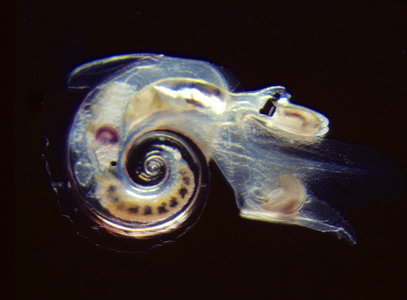
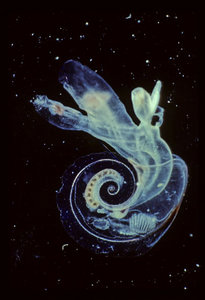
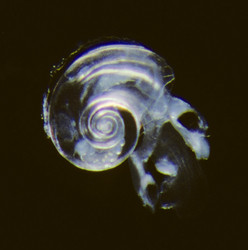
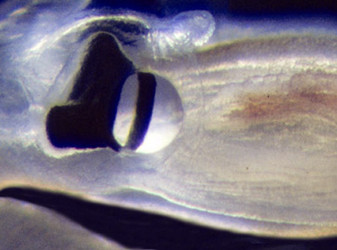
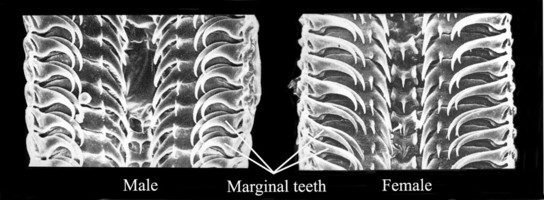




 Go to quick links
Go to quick search
Go to navigation for this section of the ToL site
Go to detailed links for the ToL site
Go to quick links
Go to quick search
Go to navigation for this section of the ToL site
Go to detailed links for the ToL site